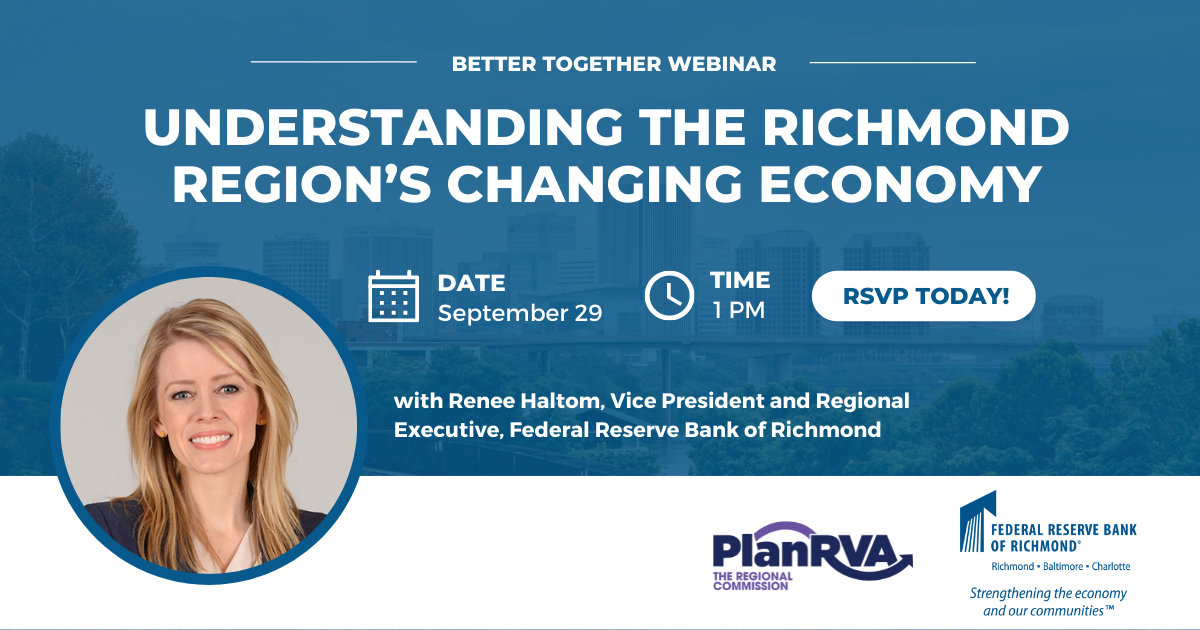Better Together Sept. 29 preview: Understanding the Richmond Region’s Changing Economy with Renee Haltom

The Better Together webinar series is back from its summer hiatus with an exciting guest: Renee Haltom, Vice President and Regional Executive at the Federal Reserve Bank of Richmond. Tune in on Thursday, Sept. 29 at 1 p.m. for an engaging conversation about local, regional, and national economic trends. To view a recording of the webinar with Renee Haltom, click here.
The Richmond Fed is one of the 12 regional Federal Reserve Banks working together with the Board of Governors to support the economy. To address economic challenges, the team at the Richmond Fed regularly engages regional leaders, policymakers and communities to better understand and solve issues. You’ll have an opportunity to learn more about this work and current trends in the upcoming Better Together session with Renee.
For a preview, we caught up with Renee for a Q&A about the Richmond Fed’s work in the community and what attendees can expect.
Can you tell us about your role at the Federal Reserve Bank of Richmond?
I’m the Vice President and Regional Executive for our Richmond office, which means I help lead our business and community outreach in the state of Virginia. I’m constantly talking to CEOs and leaders on the ground to learn about economic conditions and to share what the Fed is seeing, and I distill what we’re hearing and share back with my colleagues internally.
Some people are surprised to learn that the Fed spends so much time learning from people on the ground. We’re better known for our role in the overall economy – we set interest rates to support employment and keep inflation contained – but we know the overall data can gloss over important details about how the economy is doing. We have to look under the hood and understand differences across regions, sectors and socioeconomics.
What kind of regional indicators does the Federal Reserve Bank of Richmond track?
On the data side, we track all of the publicly available data that government agencies put together, from regional employment data to housing statistics. We make a lot of that available on our website in easy-to-use charts, graphs, and even maps. On the anecdotal side, we run our own surveys of economic conditions – monthly surveys of manufacturers and services firms, and we partner on a quarterly national CFO Survey. We also do special work understanding and supporting lower- and moderate-income communities in support of our community development mandate.
Our work talking to people on the ground is my favorite because these are opportunities to connect with and gain valuable perspectives from those engaged in the daily economic life of our communities. It fills in the picture of what’s underneath the data, it helps us understand the regions we serve, and it also tips us off to turning points in the economy. We also share what we’re seeing in the economy, so it’s very much a two-way street, and an incredibly rewarding role in a crisis like the pandemic when things can feel uncertain and scary.
Right now, for example, we’re spending lots of time listening for whether inflationary forces are coming down, how long supply chain disruptions are likely to last, and if firms are finally finding it easier to find workers since COVID. What we learn on the ground informs our Bank president’s views when he goes to Fed policy meetings, and it also influences how we think about the economy. We share as much of that as we can in places like our regional blog and our macroeconomy blog.
Why is it important for people to be aware of micro and macro trends impacting their community?
I think context is tremendously helpful. Without it, a business or community might not know if what they’re experiencing is unique to them or something more broad-based. And if it’s broad, that means others may have identified solutions, and we try to help shine a light on those too. The context we provide can empower people to make informed economic decisions.
The Fed is also an institution that serves the public, so sharing what we know and helping people understand the economy they live and work in is simply the right thing for us to do.
What can people expect during the upcoming Better Together webinar?
I’m going to talk about where we see the overall economy going, from inflation to employment to the risk of recession. I’m also going to talk about how the Richmond area fits into that, some opportunities for strengthening the region’s economy for all residents, and how the Fed can be a supportive and nonpartisan partner in that.
How can people stay connected with the Federal Reserve Bank of Richmond?
You can subscribe to our work (my favorite is the “Around Our District” newsletter). You can also reach out to me anytime you’re seeing an interesting trend the Fed should know! My email is Renee.s.haltom@rich.frb.org.
Subscribe to The Better Together Connector
Sign up to receive The Better Together Connector, a quarterly e-newsletter designed to highlight the latest efforts, successes and a look ahead from PlanRVA, the Central Virginia Transportation Authority, the Richmond Transportation Planning Organization, and the Emergency Management Alliance of Central Virginia.

